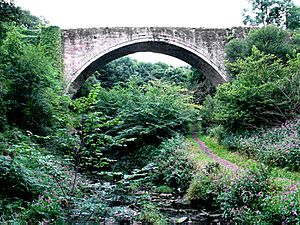Causey Arch facts for kids
The Causey Arch is a very old and famous bridge located near Stanley in County Durham, northern England. It's special because it's the oldest single-arch railway bridge still standing anywhere in the world! This bridge is a really important part of England's history, especially when it comes to how things were made and transported long ago.
Back in the day, the Causey Arch was used to carry an early type of railway called a "waggonway." Imagine horse-drawn carts rolling on wooden rails – that's what a waggonway was! These carts were used to move coal from mines to the River Tyne. Even though the railway line was later moved, the bridge still stands proudly today.
Contents
Building the Arch
The Causey Arch was built between 1725 and 1726. A skilled stonemason named Ralph Wood was the person who designed and constructed it.
Who Paid for It?
The money for the bridge came from a group of powerful coal mine owners. They were known as the "Grand Allies." This group included important people like Colonel Liddell, Charles Montague, and George Bowes, who owned the land where the bridge was built. Building the bridge was a big project, costing around £12,000 at the time.
How the Waggonway Worked
When the bridge was in use, it had two tracks. One track, called the "main way," was for carrying coal to the River Tyne. The other track, known as the "bye way," was for the empty wagons returning to the mines. More than 900 horse-drawn wagons crossed the Causey Arch every single day! This was part of the busy Tanfield Railway.
A Record-Breaking Bridge
When the Causey Arch was finished in 1726, it was the longest single-span bridge in all of England. Its arch stretched for about 31 meters (or 102 feet). This record lasted for 30 years!
Ralph Wood's Worry
After Ralph Wood designed the bridge, he was actually quite worried that his amazing arch might collapse. But his fears were for nothing! The Causey Arch has stood strong for nearly 300 years and is still here today. It only lost its record for the longest single span in 1756 when the Old Bridge was built in Pontypridd, Wales.
Later Years and Today
The bridge's use started to decline after 1739. This was when the Tanfield Colliery, one of the main coal mines it served, was sadly destroyed by a fire.
Protecting a Piece of History
The Causey Arch is so important that it has been a "Grade I listed" building since 1950. This means it's considered a building of exceptional historical and architectural interest, and it's protected by law. In the 1980s, the bridge was carefully repaired and made stronger to ensure it lasts for many more years.
Exploring the Area
Today, the area around the Causey Arch is a beautiful place to visit. There are many walking paths where you can explore the scenery. The Causey Burn, a small stream, flows right underneath the bridge. The old quarry near the bridge is also a popular spot for local rock climbers.
The Causey Burn eventually flows into Beamish Burn, which then joins the River Team, and finally empties into the mighty River Tyne.


